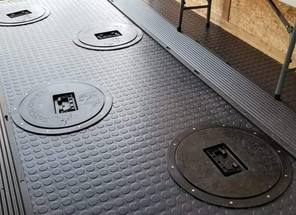Posted by Captain Troy Peterson on 3rd Oct 2019
How To Convert A Covered Trailer Into An Ice Fishing Shack
The comforts of a hard-sided shack combined with the mobility of a portable have made wheelhouse fishing increasingly popular. Gone are the days of shanty towns set on productive early ice structure that remain stationary all season long. Today’s anglers are as nomadic as the fish they pursue.
Location changes that were once difficult to pull off from one end of the lake to the other, now span the ice-belt. The ice fishing community has always been resourceful and trailer conversions have become a big part of the growth of hard house fishing. Most of the DIY crowd already have the two main ingredients - a tow vehicle and a trailer. Here are some of the advantages and disadvantages of converting a trailer and some tips and tricks I’ve learned along the way.
The Benefits
Conversions are a fraction of the cost of wheelhouses and offer a lighter platform for distance towing as well as freedom of navigation on the ice. Starting as an empty shell, it affords the designer the luxury of building to suit the individual needs and budget of the angler.
The Drawbacks

Wheelhouses are built specifically for ice fishing, and feature insulation not typically found in standard enclosed trailers, so you’ll most likely want to beef up the heater and add some insulation to the inside of the trailer. You can go about this one of two ways; the best and most efficient way is to have the inside of the trailer spray foamed. Otherwise, pink Styrofoam panels do a wonderful job as well. Insulating the ceiling is a must to cut down on condensation. Wall and floor insulation will greatly help with the heating and comfort.
Another big advantage of a wheelhouse is the ability to drop down to the ice, preventing the elements from penetrating the house from below. Of course, Catch Cover Sleeves are a great solution to this problem. Manufactured wheelhouses are generally loaded with luxury features like couches, beds, TVs, and even full kitchens. But if a loaded rig isn’t in your budget and you want to convert a covered trailer, here’s a game plan for you.
What to get
Catch Cover products are your first stop. Determine the layout and begin to cut in your Catch Cover holes. Keep in mind the framework of the trailer when setting up the placement of your holes. Purpose-built and indestructible, Catch Cover Hole Covers will allow the trailer to remain multi-purpose throughout the year. You may also want to consider Catch Cover’s detachable rod holders and Rattlesnake Reels. They are easy to move around during the season and remove completely once the ice is out for the summer. The next step is the sleeves. These slip down through the Catch Covers and fill the gap between the trailer and the ice, keeping the shack warm. You’ll want to go with the 18” Catch Cover Sleeves and trim as necessary to match the exact trailer height.
Heating
The heater I chose for my conversion had a thermostatically controlled heat setting. I went with the Dyna-Glo™ 30,000 BTU Vent-Free Wall Heater at Menards. You can probably find a similar heater at your local home improvement store. I ran the hose under the floor and up to an LP tank which was mounted to the front of the trailer tongue. This heater requires no power and will kick on and off with its built-in thermostat.
 Suggested Flooring
Suggested Flooring
There are a few options for flooring and after trial and error with painting and rubber flooring, I’ve found the best solution to be a garage-style flooring found at most home improvement stores. The G-Floor Small Coin Garage Flooring I used was enough to do the inside of the trailer along with the drop-down ramp. This flooring is incredibly durable for driving the ATV or snowmobile in and out of the trailer.
Seating
For this, I got a little creative and purchased portable picnic table benches that fold up. I am able to fold and store them out of the way when the trailer is not being used as a fish house, yet it only takes a few seconds to open them up and utilize the sidewalls as backrests.
Power & Lighting
The possibilities are endless when it comes to powering the inside of your trailer. I started with a large deep cycle battery and mounted it behind a panel inside the trailer to give it a clean, finished look. From there, I powered everything through a 12v LED switch panel. I have 2 circulation fans mounted to the ceiling on either end of the trailer along with LED strip lighting around the perimeter. Along with the lighting and fans, I have mounted a Bluetooth marine-grade stereo and smart TV for enjoyment on the slow days!
Conclusion
The real benefit of this set up was having all my gear in one place. I found myself fishing more often and lasting longer on the ice. But most of all I went further, I explored more and created better, more comfortable memories. If you have any questions while you are building your own, please feel free to ask me on my Facebook page.
Mr. Bluegill Guide Service Facebook Page
Want to learn more? Check out Troy's podcast interview detailing his experience with converting trailers into hard-sided ice fishing houses by clicking the image below.

